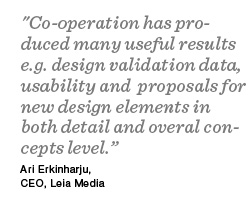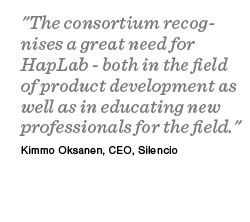More functional tablet publications are born – thanks to HabLab
The means to assess the usability of touchscreens has been lacking. As a solution, HapLab has been developed.

HapLab came into being via the Next Media project launched four years ago and aimed at the renewal of Finland’s media field. The work of Department of Media researcher Harri Heikkilä was linked with electronic reading devices and how the reading experience could be improved.
‘Touchscreens are the way of the future to read publications. So that digital publications are developed to improve them, there should be some sort of method to evaluate them. Since this sort of thing didn’t exist, it was necessary for me to develop it,’ Mr Heikkilä asserts.

The tablet heuristics developed by Mr Heikkilä are the first of their kind in the world. They are based on old heuristic models intended for computers which do not as such suit touchscreen models and are also inappropriate for the assessment of publications.
‘It’s a completely different matter to plan for a cursor instead of a finger. With touchscreens you can't use tips and the touch areas should be larger and situated in certain locations. With publications, navigation is in a more pivotal role than in traditional programs,' Mr Heikkilä adds.
Graphic designers brought into the development work
HapLab also deviates from traditional expert assessment models in the way that it does not only look for faults.
‘We’re trying to introduce the interface expertise and graphic know-how available in this facility. We point out some problematic area and conceive alternative models for it, which are then tested by users,’ Mr Heikkilä explains.
Indeed, the graphic designer of the future will increasingly be the designer of various interfaces already included at an early stage of the development work.
‘It’s not that the engineer will sit and draw boxes and the designer will do nothing more than decorate them with ribbons and bows. I believe that this approach – where the user experience is first shaped and formed, and only after that do we look at which technologies are suitable for realising it – will have ever-increasing demand,’ Mr Heikkilä says.
Faster user feedback, nimbler interaction
HapLab is designed particularly for the use of businesses in the publishing sector. The model has already been utilised in the development of Finland’s digital version of Donald Duck and Donald Duck Download Central, the iPad edition of Helsinki newspaper Helsingin Sanomat, and the tablet publication of Finland’s Swedish-language newspaper, HBL.
‘In the publishing sector, the budgets are small, and nobody there has enough money to carry out large user research. For this reason, a suitable development model for products in this sector was needed,’ Mr Heikkilä shares.
The intent is to expand the HapLab concept during the next couple of year with two modules – HapPanel and HapTalk. HapPanel is a permanent user panel, by which means feedback can be collected quickly from any sort of work.

‘The user feedback is fundamentally linked with the iterative development, but there's no sense in looking for and recruiting a community of users separately for various digitalisation projects. By means of HapPanel, we can do this on a concentrated basis,’ Mr Heikkilä points out.
HapTalk on its part is a website supporting the development effort, by which it is possible to publish and comment on videos at various stages of the development work. With HapTalk, a gap is filled in the sense that review of the feedback obtained from usability tests and assessments too seldom plays a role in the companies involved.
At HapLab, there is an attempt not only to develop mobile and table publishing and their research, but to also increase people’s knowledge and awareness. ‘We’re trying to build a world in which there is a better conception of new publishing modes and their potential. Currently, the situation is that if I speak of an eBook, it refers to a web page for one person and a Kindle reading device for another. There’s no common language. All this is just in the first stage of configuration, and for that reason it's so fascinating,' Mr Heikkilä declares.
HapLab is part of the Media Factory at Aalto University School of Arts, Design and Architecture.

Written by Noora Happonen


